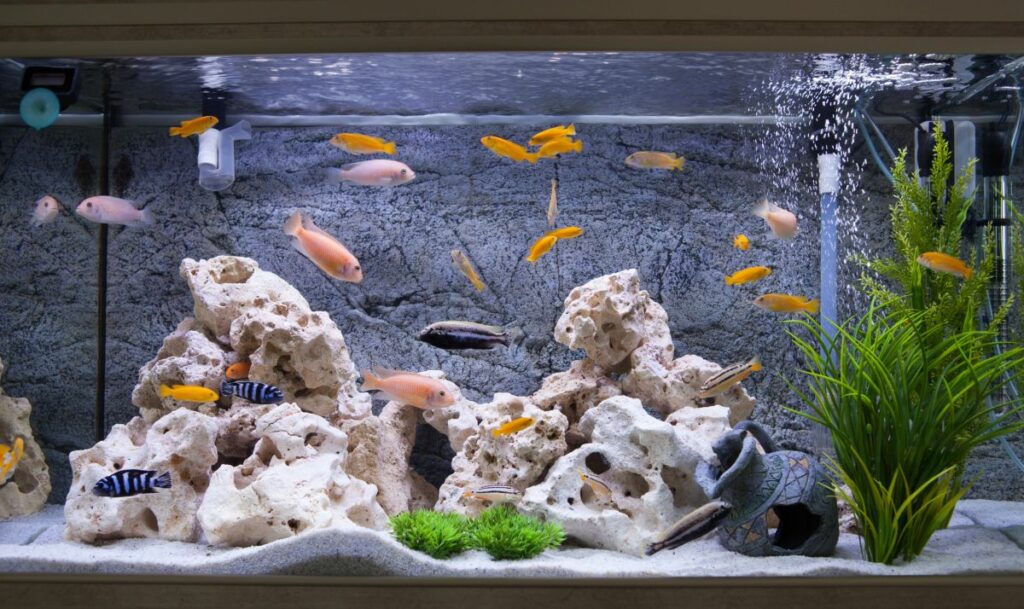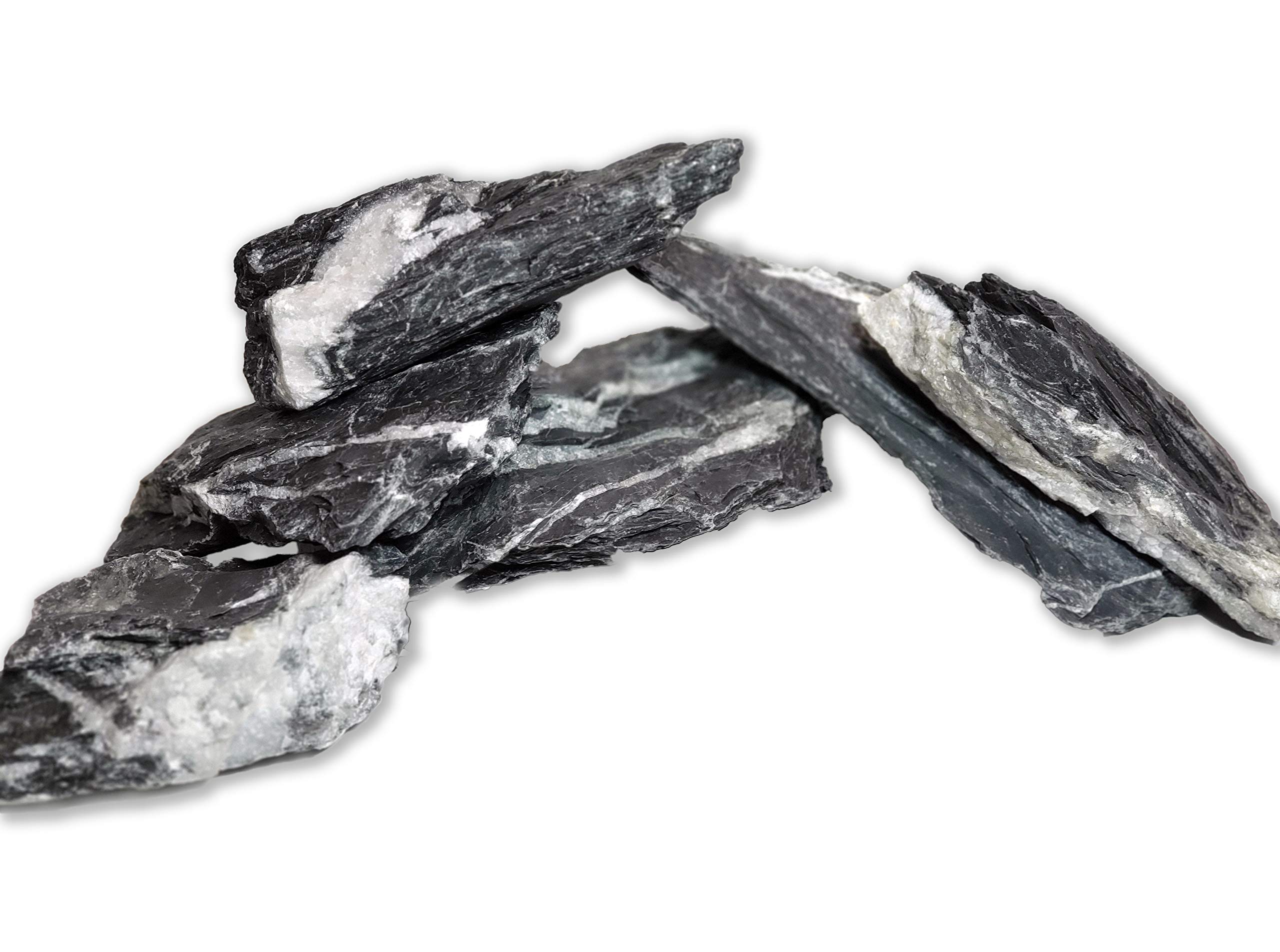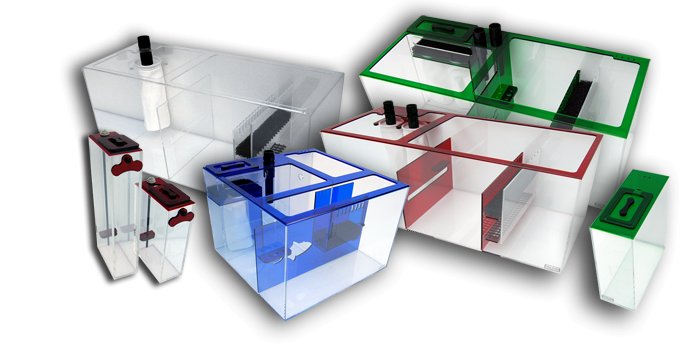10 pH-Raising Rocks for Your Aquarium: What You Need to Know!
Crushed coral and limestone rocks raise ph in aquariums effectively. Maintaining appropriate ph levels in an aquarium is essential for the health and wellbeing of aquatic life.
Most species of fish and other aquarium species, including plants and invertebrates, require a specific ph level to thrive. The ideal ph range for most aquatic life is between 6. 5 and 8. 0. However, sometimes the ph levels may drop below the appropriate range, which can be harmful to the aquarium inhabitants.
In such cases, it may be necessary to raise the ph levels of the aquarium water. A variety of items can raise ph levels in an aquarium, including rocks like crushed coral and limestone. In this article, we will discuss how these rocks raise the ph in an aquarium.

Credit: www.buildyouraquarium.com
Choosing The Right Ph-Raising Rocks:
Aquarium enthusiasts know that maintaining the ideal ph level in the water is critical for the health of aquatic creatures. Ph levels affect the behavior and immune system of fish, plants, and algae, so keeping the ph level at the right range is vital for the aquarium’s ecosystem to thrive.
While there are many ways to adjust ph levels, natural rocks are a popular choice as they offer a gradual and lasting effect. In this post, we’ll explore how you can choose the right rocks to raise the ph levels in your aquarium.
Factors To Consider When Selecting The Rocks:
When selecting rocks to raise the ph levels in your aquarium, there are a few things to keep in mind:
- First, you need to know the ph range suitable for the species that inhabit the aquarium. Different fish species have different ph preferences, so you would need to check the suitable ph level for each species in your tank.
- Second, it’s essential to be aware of the existing ph level in the aquarium before introducing rocks. Find out the ph level and start with rocks that slightly increase the ph level, so you avoid making drastic and harmful changes to your aquarium’s ecosystem.
- Third, ensure that the size of the rock is appropriate for your aquarium. Larger tanks can hold larger rocks, while smaller tanks will need smaller rocks.
Top Five Types Of Rocks For Raising Ph Levels:
- Limestone:
Limestone is an excellent choice for raising ph levels as it dissolves slowly, providing a long-term ph increase. The best type of limestone for aquariums is the calcareous variety, which contains calcium carbonate. Here are a few things to keep in mind when using limestone:
- Limestone may leach calcium and magnesium carbonates into the water. These minerals help with water hardness, but it’s important to ensure that they do not accumulate to hazardous levels.
- If limestone raises your water’s ph level too quickly, you might have to remove and replace it with fresh rocks.
- Crushed coral:
Crushed coral is another popular choice for raising the ph level in aquariums. It’s composed of the calcareous exoskeletons of coral species and releases calcium carbonate into the water, raising the ph level. Here are some things to consider when using crushed coral:
- Crushed coral is an excellent buffer that raises the carbonate hardness level while also increasing the ph level. The buffering capacity means that it releases minerals slowly over time, providing a consistent ph level.
- Crushed coral is a slow-dissolving rock, so it’s ideal for tanks with high water flow, as it will gradually release minerals over time.
- Dolomite:
Dolomite is a rock that is rich in magnesium, calcium, and carbonate. It helps to stabilize the aquarium’s ph level by increasing alkalinity and hardness levels. Here are some things to consider when using dolomite:
- If your water source already has high levels of magnesium or calcium, using dolomite can lead to hazardous levels of minerals in the water. Ensure that you source dolomite of high purity to avoid this problem.
- Dolomite does not dissolve readily, so it’s an effective buffer for aquariums with high water flow.
- Aragonite:
Aragonite is a carbonate mineral that is beneficial for raising ph levels in aquariums. It’s especially useful for aquariums with a low ph level. Here are some things to consider when using aragonite:
- Aragonite is an excellent substrate for reef aquariums as it promotes biological filtration and enhances mineral content.
- It’s also a good choice for aquariums with live plants as it doesn’t harm their growth.
- Texas holey rock:
The texas holey rock is a limestone rock that is often sold for aquarium use. It’s distinguished by its many holes and crevices that fish love to explore. Here are some things to consider when using texas holey rocks:
- Texas holey rock raises the ph levels and water hardness levels, providing a stable environment for your aquarium’s inhabitants.
- It’s essential to ensure that you get the right size of rock for your aquarium, bearing in mind that it’s a heavy rock.
Prepping And Maintenance Of Ph-Raising Rocks:
Aquariums can be a great way to bring a bit of nature into your home, but they can also be tricky to maintain. One critical factor that affects the health of your aquarium’s inhabitants is the ph level. Many factors can cause ph levels to drift too low, causing stress or even harm to the animals in your aquarium.
One way to help maintain proper ph levels is by using ph-raising rocks.
Step-By-Step Guides On How To Prepare The Rocks Before Using Them
Before you add ph-raising rocks to your aquarium, it’s crucial to prepare them correctly. Here are the steps you should follow:
- Wash the rocks thoroughly with water to remove any dirt or debris
- Soak the rocks in a bucket of water for a few days or more to leach out any contaminants that could affect the ph levels in your aquarium.
- Test the water in your bucket when you remove the rocks. The ph level of the water should match the ph level of your aquarium’s water. If it’s too high, adjust it down with a ph neutralizer before adding the rocks to your aquarium.
Tips For Maintaining The Rocks Over Time To Maintain Healthy Ph Levels
Once you’re using ph-raising rocks in your aquarium, it’s crucial to ensure that they continue to work effectively over time. Here are some tips to keep in mind:
- Monitor the ph levels in your aquarium regularly. If you notice a drop in the ph level, it may be time to replace the rocks.
- Clean the rocks regularly to prevent any buildup of dirt or debris that could affect the ph level in your aquarium.
- Be sure to replace the rocks periodically, even if they appear to be working correctly. Over time, they may wear down and become less effective.
Explanation Of Common Mistakes To Avoid When Using The Rocks To Raise Ph Levels In Your Aquarium
While using ph-raising rocks can be an effective way to maintain a healthy ph level in your aquarium, there are some common mistakes to avoid:
- Do not use rocks that have been treated with chemicals or pesticides, as these could harm your aquarium’s inhabitants.
- Do not rely solely on ph-raising rocks to maintain a healthy ph level. Other factors, such as water changes and proper filtration, are also crucial.
- Do not add too many rocks at once, as this can cause a sudden spike in ph levels that could be harmful to your aquarium’s inhabitants.
By following these tips and guidelines, you can use ph-raising rocks safely and effectively in your aquarium. Just remember to monitor the ph levels in your aquarium regularly and take action as needed to ensure your aquarium’s inhabitants remain healthy and happy.
Common Challenges With Ph-Raising Rocks:
Discussion Of Some Common Obstacles That Might Arise While Using The Rocks To Raise Your Aquarium’S Ph Level
Using rocks to raise ph levels in aquariums is a common practice among aquarists. However, there are several common challenges that may arise when trying to elevate ph levels using rocks. Here are some of the most prevalent challenges and how you can deal with them:
- ### the source of the rock
The source of the rock you use plays a key role in determining its effect on the ph levels of your aquarium. Some rocks may contain minerals that could alter the ph drastically. For example, limestone is known to release carbonate ions, which raises the ph levels of water.
On the other hand, granite is unlikely to affect the water’s ph levels significantly. To avoid potential problems, consider the type of rocks you are using for your aquarium.
- ### over-raising ph levels
Over-raising the ph levels of water can be fatal to fish and other aquatic organisms. Rocks tend to increase the alkalinity of water, which in turn raises the ph levels. If the ph levels rise to a point where fish cannot survive, it could lead to fatalities.
To avoid this, monitor the ph levels frequently, and remember to adjust the levels gradually.
- ### crumbling rocks
Some rocks crumble over time, leading to a buildup of rock dust in the aquarium. If this happens, the rock dust could cause the ph levels to fluctuate. Additionally, the dust could harm fish within the aquarium if inhaled. To avoid this, wash the rocks thoroughly, remove any loose pieces, and test them well before introducing them to your aquarium.
How To Deal With Those Challenges
Here are some tips that could help you overcome the challenges of using rocks to raise ph levels in your aquarium.
- Do research on the type of rocks you intend to use before introducing them to the aquarium. This will help you avoid using rocks that will raise ph levels beyond a safe range.
- Monitor ph levels frequently and adjust them gradually.
- Remove any crumbling rocks, and clean the aquarium regularly to avoid fluctuations in ph levels.
- Use ph level testing kits to monitor the level of alkalinity in the aquarium is ideal for the fish there.
How To Avoid Future Potentially Problematic Situations
Prevention is always better than cure. Here are some tips on how to avoid situations where using rocks to raise ph levels in your aquarium could become problematic.
- Use rocks that are specifically designed for aquarium use.
- Avoid using rocks that contain minerals which may alter the ph levels of water significantly.
- Test the ph levels frequently to ensure that they are within a safe range for fish and other aquatic organisms.
- Clean the aquarium regularly to avoid fluctuations in ph levels.
Using rocks to raise ph levels in an aquarium is an effective technique that requires care and attention. Understanding the challenges that may arise and how to deal with them will enable you to maintain a healthy and safe environment for your fish and other aquatic organisms.
Remember to conduct ample research before introducing any rocks to your aquarium, and always monitor ph levels frequently.
Guidelines For Using Ph-Raising Rocks In Your Aquarium:
Raising the ph level in an aquarium is an essential aspect of maintaining a healthy environment for your aquatic pets. One of the best ways of doing this is by using ph-raising rocks. However, it’s crucial to follow specific guidelines to ensure that your aquarium remains in good shape.
Here are some tips on how to use ph-raising rocks effectively:
Tips For Effective Use And Placement Of The Rocks In Your Aquarium:
The proper placement of ph-raising rocks plays a vital role in maintaining the right ph level for your aquarium. Here are some tips to follow:
- Place the rocks evenly around the aquarium to prevent the ph level from rising too fast in one area, which can be detrimental to your aquatic pets.
- You can place the rocks beneath the substrate as it prevents the rise in ph levels from disturbing the habitat of your fish.
- Avoid placing the rocks in direct contact with any live aquarium plants as they can be sensitive to the ph swings caused by the rocks.
Proper Dosing And Aquarium Inhabitant Requirements To Ensure Healthy Ph Levels:
When using ph-raising rocks, proper dosing is crucial for maintaining a healthy ph level for your aquarium inhabitants. Here are some guidelines to follow:
- It’s essential to test the ph level regularly to ensure that it’s within the desired range.
- Introduce ph-raising rocks gradually to prevent a sudden rise in ph levels that can shock or harm your aquarium pets.
- Dosage requirements depend on the type of rocks used, the size of the aquarium, and the current ph level. Always follow the instructions on the packaging or seek advice from a professional aquarist.
- Some aquarium fish and invertebrates have specific ph requirements, and using ph-raising rocks can cause stress and harm to them. Before using any rock, research the requirements of your aquarium inhabitants and choose rocks that suit them.
Possible Precautions To Take When Raising The Ph Level Of Your Aquarium Water:
When using ph-raising rocks, it’s crucial to take necessary precautions to prevent run-ins with undesirable incidents. Here are some precautions to keep in mind:
- Using too many rocks can cause a sudden spike in ph levels, which can be harmful to your aquatic pets. Start with a small dosage and monitor the ph level before adding more rocks.
- Avoid using multiple methods to raise the ph level simultaneously as it can lead to a sudden swing in the ph level, causing harm to your aquarium inhabitants.
- If you notice any abnormal behavior in your fish or other inhabitants, check the ph level immediately and seek professional help if needed.
- Finally, be mindful of the water hardness and ph level before adding any rocks to your aquarium. Use a water test kit to measure the alkalinity and hardness.
Frequently Asked Questions On What Rocks Raise Ph In Aquarium
What Rocks Raise Ph In Aquariums?
Certain rocks like limestone and dolomite can raise ph in aquariums due to their alkaline nature.
Is It Safe To Use Rocks In Aquariums?
It depends on the type of rocks. Some rocks like granite and quartz are safe, while others like limestone can alter the water chemistry.
How Do You Test Ph Levels In Aquariums?
You can use a ph test kit or ph meter to test the ph levels in aquariums. Follow the manufacturer’s instructions carefully for accurate results.
How Often Should You Test Ph Levels In Aquariums?
You should test ph levels in aquariums at least once a week. If you notice any changes in fish behavior or water chemistry, test more frequently.
Conclusion
Based on the information provided, it is clear that rocks are a valid option to raise ph levels in an aquarium. Whether you prefer limestone, seashells, or coral, these materials can provide a natural, long-lasting solution for those struggling with low ph levels.
It is important, however, to use caution when selecting and adding these rocks to your aquarium. Careful research and monitoring will help ensure the safety and well-being of your aquatic pets. Additionally, regular water testing and ph level monitoring will help you address any potential changes in the ph balance of your aquarium.
By considering all of these factors, you can confidently select the best rock option for your aquarium and enjoy a thriving, healthy aquatic environment for your pets.






